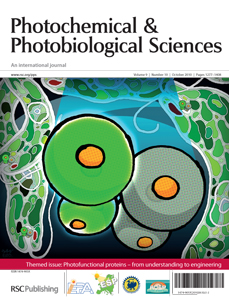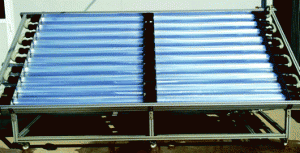This month sees the following articles in Photochemical & Photobiological Sciences that are in the top ten most accessed:-
Highly emissive metal organic framework composites by host-guest chemistry
Maike Müller, André Devaux, Cheng-Han Yang, Luisa De Cola and Roland A. Fischer
Photochem. Photobiol. Sci., 2010, 9, 846-853, DOI: 10.1039/C0PP00070A
Iridium(iii) luminophores as energy donors for sensitised emission from lanthanides in the visible and near-infrared regions
Nicholas M. Tart, Daniel Sykes, Igor Sazanovich, Ian S. Tidmarsh and Michael D. Ward
Photochem. Photobiol. Sci., 2010, 9, 886-889, DOI: 10.1039/C0PP00011F
Novel photosensitisers derived from pyropheophorbide-a: uptake by cells and photodynamic efficiency in vitro
Ioanna Stamati, Marina K. Kuimova, Mattia Lion, Gokhan Yahioglu, David Phillips and Mahendra P. Deonarain
Photochem. Photobiol. Sci., 2010, 9, 1033-1041, DOI: 10.1039/C0PP00038H
Probing the interactions between disulfide-based ligands and gold nanoparticles using a functionalised fluorescent perylene-monoimide dye
Julien R. G. Navarro, Marcel Plugge, Matthieu Loumaigne, Angel Sanchez-Gonzalez, Benedetta Mennucci, Anne Débarre, Albert M. Brouwer and Martinus H. V. Werts
Photochem. Photobiol. Sci., 2010, 9, 1042-1054, DOI: 10.1039/C0PP00063A
A photo- and electrochemically-active porphyrin-fullerene dyad electropolymer
Miguel Gervaldo, Paul A. Liddell, Gerdenis Kodis, Bradley J. Brennan, Christopher R. Johnson, James W. Bridgewater, Ana L. Moore, Thomas A. Moore and Devens Gust
Photochem. Photobiol. Sci., 2010, 9, 890-900, DOI: 10.1039/C0PP00013B
Human Safety Review of “Nano” Titanium Dioxide and Zinc Oxide
Karsten Schilling, Bobbie Bradford, Dominique Castelli, Eric Dufour, J. Frank Nash, Wolfgang Pape, Stefan Schulte, Ian Tooley, Jeroen van den Bosch and Florian Schellauf
Photochem. Photobiol. Sci., 2010, 9, 495-509, DOI: 10.1039/B9PP00180H
Exploring the effects of solvent polarity on the rate of Förster-type electronic energy transfer in a closely-spaced molecular dyad
Anthony Harriman and Raymond Ziessel
Photochem. Photobiol. Sci., 2010, 9, 960-967, DOI: 10.1039/C0PP00062K
Transduction of excited state energy between covalently linked porphyrins and phthalocyanines
Anita Hausmann, Ana R. M. Soares, M. Victoria Martínez-Díaz, Maria G. P. M. S. Neves, Augusto C. Tomé, José A. S. Cavaleiro, Tomas Torres and Dirk M. Guldi
Photochem. Photobiol. Sci., 2010, 9, 1027-1032, DOI: 10.1039/C0PP00060D
Generalized solvent scales as a tool for investigating solvent dependence of spectroscopic and kinetic parameters. Application to fluorescent BODIPY dyes
Aleksander Filarowski, Małgorzata Kluba, Katarzyna Cieślik-Boczula, Aleksander Koll, Andrzej Kochel, Lesley Pandey, Wim M. De Borggraeve, Mark Van der Auweraer, Javier Catalán and Noël Boens
Photochem. Photobiol. Sci., 2010, 9, 996-1008, DOI: 10.1039/C0PP00035C
Distance and orientation dependence of photoinduced electron transfer through twisted, bent and helical bridges: a Karplus relation for charge transfer interaction
René M. Williams
Photochem. Photobiol. Sci., 2010, 9, 1018-1026, DOI: 10.1039/C0PP00050G
Why not take a look at the articles today and blog your thoughts and comments below.
Fancy submitting an article to PPS? Then why not submit to us today or alternatively email us your suggestions.
Comments Off on Top ten most accessed articles in July
 Our latest themed issue on Photofunctional proteins: from understanding to engineering, is now online. The issue was guest edited by Professors Aba Losi, Cristiano Viappiani and Santi Nonell.
Our latest themed issue on Photofunctional proteins: from understanding to engineering, is now online. The issue was guest edited by Professors Aba Losi, Cristiano Viappiani and Santi Nonell.










